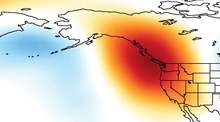Ridiculously Resilient Ridge

The "Ridiculously Resilient Ridge," sometimes shortened to "Triple R" or "RRR," is the nickname given to a persistent region of atmospheric high pressure that occurred over the far northeastern Pacific Ocean.[1] The "Ridiculously Resilient Ridge" nickname was coined in December 2013 by Daniel Swain on the California Weather Blog.[2]
Features
The Ridiculously Resilient Ridge is characterized by a broad region of positive geopotential height anomalies on monthly to annual timescales. This persistent ridging acts to "block" the prevailing mid-latitude Westerlies, shifting the storm track northward and suppressing extratropical cyclone (winter storm) activity along the West Coast of the United States. Such a pattern is similar to—but of greater magnitude and longevity than—atmospheric configurations noted during previous California droughts.
Associations
This anomalous atmospheric feature disrupted the North Pacific storm track during the winters of 2012-2013, 2013-2014 and 2014-2015, resulting in extremely dry and warm conditions in California and along much of the West Coast, contributing to the 2012–15 North American drought.[3][4] The Ridge comprises the western half of an atmospheric ridge-trough sequence associated with the highly amplified "North American dipole" pattern, which brought persistent anomalous cold and precipitation to the eastern half of North America[5] during 2014 in addition to record-breaking warmth and drought conditions in California.[6]
This ridge of high pressure has contributed to a blob of high water temperatures in the Pacific Ocean, which has in and of itself caused changes in weather patterns for North America.[7] However, causality is not established whether the RRR exists because of the blob, or the blob exists because of the RRR.
The RRR is also associated with the prolonged drought over California as of early 2016, which has shown up as reduced rainfall in Southern California in particular, despite with rather normal snowpack in the Sierras, as well as being suspected, but not yet conclusively proven, to be induced by global warming.[8]
See also
References
- ↑ Bartlett, Max (27 June 2016). "Summer Weather Is Hard To Predict, Especially With The "Ridiculously Resilient Ridge"". Northwest Public Radio. Retrieved 29 June 2016.
- ↑ "The extraordinary California dry spell continues: 2013 will probably be the driest year on record".
- ↑ "The Extraordinary California Drought of 2013/14: Character, Context, and the Role of Climate Change" (PDF).
- ↑ "The Ridiculously Resilient Ridge continues into 2014; California drought intensifies".
- ↑ "A Cold U.S. Winter for Sure, but 8th Warmest Globally".
- ↑ "In California, record heat adding to extreme drought".
- ↑ Almasy, Steve; Hennen, Dave; Gray, Jennifer (22 April 2015). "Blob of warm Pacific water threatens ecosystem, may intensify drought". CNN. Retrieved 14 August 2015.
- ↑ http://www.livescience.com/54266-california-droughts-blamed-on-ridiculously-resilient-ridge.html